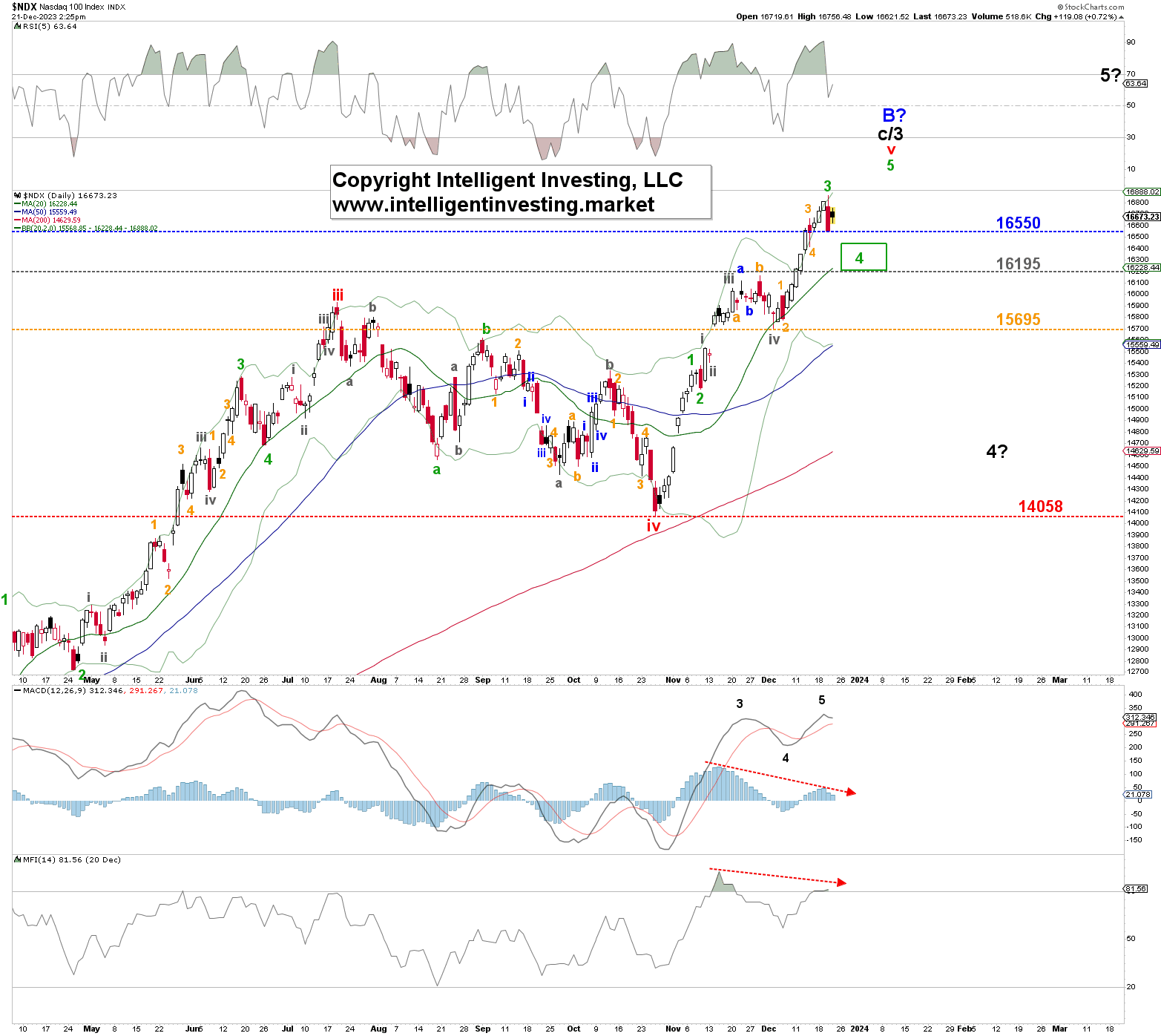Nasdaq 100’s Larger Top
2023.12.21 16:39
First, let’s take a quick trip down memory lane to understand the current price action of the better.
- In late July, see , we were looking for one more push higher before a top would form but warned that a drop below $15375 would be the first signal the index was ready to embark to ideally $14400+/-200. The index followed up on this warning.
- In mid-August, see , we warned that the Bull trap door was set. Although the market threw the obligatory and occasional curve ball, by October 26, it had bottomed out at $14058, only 1% below the ideal target zone set three months prior.
- In October, see and , we were a bit early as we wondered if the index was getting ready to rally to $16100-660+.
- In early November, see , we followed up on our assessment that the low was most likely in place and that the index could still reach $1660+, assuming a standard Fibonacci-based impulse pattern. See Figure 1 below.
- Lastly, in late November, see , we showed that a local top most likely was brewing, targeting ideally $15850+/-100 before the rally to ideally $16315-620 would continue. The index bottomed at $15695, topped yesterday at $16860, and now trades at $16670s.
Although we can never correct every twist and turn, the markets did not adhere to the anticipated larger standard impulse pattern from the October 26 low either. Allow us to explain.
Figure 1

The current move from the recent October low has not even seen a 23.60% retracement. The most significant “pullback,” the December 4 low, was only -2.8%. Even the relentless rally off the 2020 bottom had several ~38.20% retracements and certainly several 23.60% retracements. We do not recall a move of this magnitude that did not have at least a 23.60% pullback. Hence, the current rally is a significant outlier that is unforeseeable when it starts. However, and therefore, it smells of a 5th wave.
Namely, when we track the stock markets, we use objective standards, i.e., the standard Fibonacci-based impulse pattern, which applies most of the time. But, since the markets do not owe us anything as they say, sometimes the financial markets choose to move outside those standards. Therefore, we cannot foresee all market moves like the one we are currently experiencing. However, just because the Fib-based pattern is not followed doesn’t mean the EWP doesn’t work—quite the contrary. Namely, financial markets are complex systems like the weather and can never always be correctly forecasted. Moreover, the list of our articles above shows we have mostly been right on track. Thus, applying the time-tested objective standards provides appropriate risk management at all times, which is the most critical aspect of trading.
Thus, currently, we are dealing with a price pattern that is truly out of the ordinary for stock markets, which renders the smaller wave structures less transparent, so we have to adjust our EWP count since the October 26 low more frequently than usual. See Figure 2 below.
Figure 2

There are only a few rules in the EWP; one is that the 3rd wave cannot be the shortest. Initially, we had labeled the November high and December low as green W-3 and W-4, respectively. However, that would mean W-5 could not exceed $16695. The index exceeded that cut-off on Monday, so we adjusted our EWP accordingly. Figure 2 shows that yesterday’s high at $16860 was most likely a green W-3 high. Reasonably close to the 138.20% extension of green W-1, measured from W-2 at $16925. A typical 3rd wave target. The index should now be in green W-4 to ideally $16,195-440. But remember that pullbacks have been almost non-existent in this rally so the downside may disappoint. Namely, as explained, there is no standard Fib-based impulse pattern off the October 26 low, which otherwise would have made our lives much more manageable. But who said analyzing (and trading) the stock markets would be easy?
Thus, our primary expectation was for the index to top out, as we forecasted it could several months ago, at $16100-660+. Yesterday, it reached $16860. Now, we expect the NDX to bottom between, ideally, $ 16,195-440 before rallying to, ideally, $ 17,230+/-50. The first warning for the Bulls that W-4 is still progressing is on a break and daily close below $16550. However, the 2nd warning for the Bulls is below $16195, and then the 4th wave -especially in light of the recent rally- is getting rather deep. The 3rd warning is below $15695 as the rally from the October low will have ended. When that happens, we will look for the index to
- either have put in a long-term top (blue W-B) and set course for the low $1000s or
- present us with “only” a drop to ideally around $14700+/-100 for the black W-4?, before a final rally to as high as $18000+ for the black W-5?.
Hence, at this point, it would be appropriate to assess the short- to long-term risk/reward at current price levels, and the warning levels above can be used as one’s insurance policy to prevent potential havoc on one’s portfolio.







